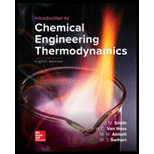
Introduction to Chemical Engineering Thermodynamics
8th Edition
ISBN: 9781259696527
Author: J.M. Smith Termodinamica en ingenieria quimica, Hendrick C Van Ness, Michael Abbott, Mark Swihart
Publisher: McGraw-Hill Education
expand_more
expand_more
format_list_bulleted
Textbook Question
Chapter 14, Problem 14.41P
The following problems involving chemical-reaction stoichiometry are to be solved through the use of reaction coordinates.
- Feed to a gas-phase reactor comprises 50 kmol+h-1 of species A, and 50 kmol+h-1 of species B. Two independent reactions occur:
A + B → C (I)
A + C → D (II)
Analysis of the gaseous effluent shows mole fractions ya= 0.05 and yB= 0.10.
- What is the reactor effluent rate in kmol+h-1 ?
- What are the mole fractions yC and yD in the effluent?
A + B → C (I)
A + 2B → D (II)
Analysis of the gaseous effluent shows mole fractions: yc = 0.52 and yD = 0.04. Determine the rates (kmol+h-1) of all species in the effluent stream.
A + B → D (II)
Reaction (I) produces valuable species C and coproduct B. The side reaction (II) produces by-product D. Analysis of the gaseous effluent shows mole fractions yc = 0.30 and YD= 0.10. Determine the rates (kmol+h-1) of all species in the effluent stream.
A + B → D + E (II)
Analysis of the gaseous effluent shows mole fractions yc = 0.25 and yD = 0.20. Determine:
- Rates in kmol+h-1 of all species in the effluent stream.
- Mole fractions of all species in the effluent stream.
Expert Solution & Answer
Want to see the full answer?
Check out a sample textbook solution
Chapter 14 Solutions
Introduction to Chemical Engineering Thermodynamics
Ch. 14 - Prob. 14.1PCh. 14 - A system initially containing 2 mol C2H4 and 3 mol...Ch. 14 - A system formed initially of 2 mol CO2 , 5 mol H2...Ch. 14 - Consider the water-gas-shift reaction:...Ch. 14 - Rework Prob. 14.4 for a temperature of: (a) HOOK:...Ch. 14 - Use the method of equilibrium constants to verify...Ch. 14 - Prob. 14.7PCh. 14 - For ideal gases, exact mathematical expressions...Ch. 14 - For the ammonia synthesis reaction written:...Ch. 14 - Peter. Paul, and Mary, members of a thermodynamics...
Ch. 14 - The following reaction reaches equilibrium at...Ch. 14 - The following reaction reaches equilibrium at...Ch. 14 - The following reaction reaches equilibrium at...Ch. 14 - The following reaction, hydrogenation of styrene...Ch. 14 - The gas stream from a sulfur burner is composed of...Ch. 14 - Prob. 14.16PCh. 14 - Ethylene is produced by the dehydrogenation of...Ch. 14 - The production of 1,3-butadiene can be carried out...Ch. 14 - The production of 1,3-butadiene can be carried out...Ch. 14 - For the ammonia synthesis reaction, 12N2g+32H2NH3g...Ch. 14 - Prob. 14.21PCh. 14 - Prob. 14.22PCh. 14 - Ammonium chloride NH4Cls decomposes upon heating...Ch. 14 - A chemically reactive system contains the...Ch. 14 - The relative compositions of the pollutants NO and...Ch. 14 - Carbon black is produced by the decomposition of...Ch. 14 - Consider the reactions 12N2g+12O2gNOg12N2g+O2gNO2g...Ch. 14 - Oil refineries often have both H2S and SO2 to...Ch. 14 - Species N2O4 and NO2 as gases come to equilibrium...Ch. 14 - The following isomerization reaction occurs in the...Ch. 14 - Prob. 14.32PCh. 14 - The feed gas to a methanol synthesis reactor is...Ch. 14 - Prob. 14.34PCh. 14 - Consider the gas-phase isomerization reaction: ....Ch. 14 - A low-pressure, gas-phase isomerization reaction,...Ch. 14 - Set up the equations required for solution of Ex....Ch. 14 - Reaction-equilibrium calculations may be useful...Ch. 14 - Ethylene oxide as a vapor and water as liquid,...Ch. 14 - In chemical-reaction engineering, special measures...Ch. 14 - The following problems involving chemical-reaction...Ch. 14 - The following is an industrial-safety rule of...Ch. 14 - Prob. 14.43PCh. 14 - The standard heat of reaction A/f3 for gas-phase...Ch. 14 - Ethanol is produced from ethylene via the...Ch. 14 - A good source for formation data for compounds is...Ch. 14 - Reagent-grade, liquid-phase chemicals often...Ch. 14 - Cracking propane is a route to light olefin...Ch. 14 - Equilibrium at 425 K and 15 bar is established for...
Knowledge Booster
Learn more about
Need a deep-dive on the concept behind this application? Look no further. Learn more about this topic, chemical-engineering and related others by exploring similar questions and additional content below.Recommended textbooks for you
 Introduction to Chemical Engineering Thermodynami...Chemical EngineeringISBN:9781259696527Author:J.M. Smith Termodinamica en ingenieria quimica, Hendrick C Van Ness, Michael Abbott, Mark SwihartPublisher:McGraw-Hill Education
Introduction to Chemical Engineering Thermodynami...Chemical EngineeringISBN:9781259696527Author:J.M. Smith Termodinamica en ingenieria quimica, Hendrick C Van Ness, Michael Abbott, Mark SwihartPublisher:McGraw-Hill Education Elementary Principles of Chemical Processes, Bind...Chemical EngineeringISBN:9781118431221Author:Richard M. Felder, Ronald W. Rousseau, Lisa G. BullardPublisher:WILEY
Elementary Principles of Chemical Processes, Bind...Chemical EngineeringISBN:9781118431221Author:Richard M. Felder, Ronald W. Rousseau, Lisa G. BullardPublisher:WILEY Elements of Chemical Reaction Engineering (5th Ed...Chemical EngineeringISBN:9780133887518Author:H. Scott FoglerPublisher:Prentice Hall
Elements of Chemical Reaction Engineering (5th Ed...Chemical EngineeringISBN:9780133887518Author:H. Scott FoglerPublisher:Prentice Hall
 Industrial Plastics: Theory and ApplicationsChemical EngineeringISBN:9781285061238Author:Lokensgard, ErikPublisher:Delmar Cengage Learning
Industrial Plastics: Theory and ApplicationsChemical EngineeringISBN:9781285061238Author:Lokensgard, ErikPublisher:Delmar Cengage Learning Unit Operations of Chemical EngineeringChemical EngineeringISBN:9780072848236Author:Warren McCabe, Julian C. Smith, Peter HarriottPublisher:McGraw-Hill Companies, The
Unit Operations of Chemical EngineeringChemical EngineeringISBN:9780072848236Author:Warren McCabe, Julian C. Smith, Peter HarriottPublisher:McGraw-Hill Companies, The

Introduction to Chemical Engineering Thermodynami...
Chemical Engineering
ISBN:9781259696527
Author:J.M. Smith Termodinamica en ingenieria quimica, Hendrick C Van Ness, Michael Abbott, Mark Swihart
Publisher:McGraw-Hill Education

Elementary Principles of Chemical Processes, Bind...
Chemical Engineering
ISBN:9781118431221
Author:Richard M. Felder, Ronald W. Rousseau, Lisa G. Bullard
Publisher:WILEY

Elements of Chemical Reaction Engineering (5th Ed...
Chemical Engineering
ISBN:9780133887518
Author:H. Scott Fogler
Publisher:Prentice Hall


Industrial Plastics: Theory and Applications
Chemical Engineering
ISBN:9781285061238
Author:Lokensgard, Erik
Publisher:Delmar Cengage Learning

Unit Operations of Chemical Engineering
Chemical Engineering
ISBN:9780072848236
Author:Warren McCabe, Julian C. Smith, Peter Harriott
Publisher:McGraw-Hill Companies, The
Chemical Equilibria and Reaction Quotients; Author: Professor Dave Explains;https://www.youtube.com/watch?v=1GiZzCzmO5Q;License: Standard YouTube License, CC-BY
Chemical Equilibrium Constant K - Ice Tables - Kp and Kc; Author: The Organic Chemistry Tutor;https://www.youtube.com/watch?v=J4WJCYpTYj8;License: Standard Youtube License